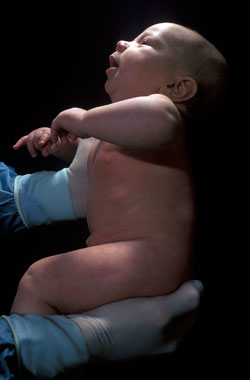BERKELEY, CA (UroToday.com) - Juvenile granulosa cell tumors (JGCT) are very rare tumors in males. In literature, about 60 cases of JGCTs have been discovered in males, in total. JGCT is primarily diagnosed early after birth until the end of the first year of life. Mostly they appear as an abnormal testicular formation in the scrotum and only one-sixth of these tumors are found intraabdominally as the testis has not descended into the scrotum. An abnormal sexual phenotype, such as ambiguous genitalia or hermaphroditism, was commonly present. The male of our report had normal phenotype of the rest of his genitalia and no other anomaly was detected. Family history was negative for any tumor presence or sexual deformities. On one-year follow-up, the growth was normal and still no alteration of the normal anatomy was detected.
 Karyotype analysis was inducted in one-fourth of the cases in literature and half of them had some chromosome anomaly. In our case, we consider that a karyotype analysis should have been done, although the phenotype was normal, to detect even a minor chromosome abnormality, but the parents refused.
Karyotype analysis was inducted in one-fourth of the cases in literature and half of them had some chromosome anomaly. In our case, we consider that a karyotype analysis should have been done, although the phenotype was normal, to detect even a minor chromosome abnormality, but the parents refused.
Referring to our diagnostic sequence, first an empty left scrotum was discovered and during the search for the testicle, the tumor was palpated. An x-ray was consequently performed to exclude ileus or obstruction, and it revealed a radio transparent lesion at the left lower abdominal quadrant. Afterwards, an abdominal ultrasound was conducted which revealed a cystic formation originating from the intestine. As a result, the proposed diagnosis was intestinal duplication. The false diagnosis is believed to be due to the cystic consistency of the tumor and due to the nature of ultrasonography as a test, the result of which depends on the experience of the radiologist and is subjective.
As for the treatment of such tumors, partial orchiectomy is proposed when possible. Otherwise, total orchiectomy is favored to radical orchiectomy, as reported JGCTs have been benign so far, have not been hormonally active, do not grow much in diameter, and have never shown positive lymph nodes. The operation should be performed as soon as possible because there is always a possibility of carcinogenesis and metastasis because of a new mutation, especially if the testis is intra-abdominal, as factors of the abdominal environment (e.g. elevated temperature) are believed to increase the risk for mutations and carcinogenesis. In our case, total orchiectomy with enucleation techniques was performed because the entire testis was cystic and was adjusted to the epididymis.
Written by:
Nikolaos Partalis as part of Beyond the Abstract on UroToday.com. This initiative offers a method of publishing for the professional urology community. Authors are given an opportunity to expand on the circumstances, limitations etc... of their research by referencing the published abstract.



